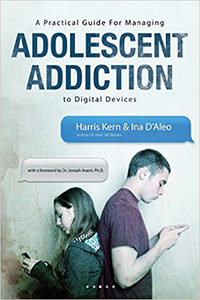A Practical Guide for Managing Adolescent Addiction to Digital Devices
- Publisher: Koehler Books (September 1, 2016)
- Language: English
- ISBN-10: 1633933296
- ISBN-13: 978-1633933293
- Buy from Amazon.com
It’s difficult to imagine life without laptops, Smartphones, and other digital devices. We utilize technology as an enabler to manage our lives. Unfortunately, with most teens (and many adults), technology is an obsession resulting in a 24-hour distraction, and even a technological addiction. This constant distraction is negatively impacting development of adulthood skills related to crucial priorities i.e., career, health, relationships and finances.
Not to mention the adverse health and safety issues:
- 11 teens die every day as a result of texting while driving.
- According to a AAA poll, 94% of teen drivers acknowledge the dangers of texting and driving, but 35% admitted to doing it anyway.
- 21% of teen drivers involved in fatal accidents were distracted by their cell phones.
- Teen drivers are 4x more likely than adults to get into car crashes or near-crashes when talking or texting on a cell phone.
- A teen driver with only one additional passenger doubles the risk of getting into a fatal car accident. With two or more passengers, they are 5x as likely.
In a Washington Post article “Teens say they’re addicted to technology. Here’s how parents can help,” author Amy Joyce states that according to a new report of Common Sense Media, 50 percent of teens actually admitted that they feel addicted. Just imagine what the real number is. Not only do teens feel that they can’t put their devices down, but their parents know it (59 percent) and many parents themselves can’t put their own devices down (27 percent) as well.
Authors Harris Kern and Ina D’Aleo tackle these problems and issues in a way that parents and professionals can understand, and in the hope that we can keep our adolescents safe and healthy.


















